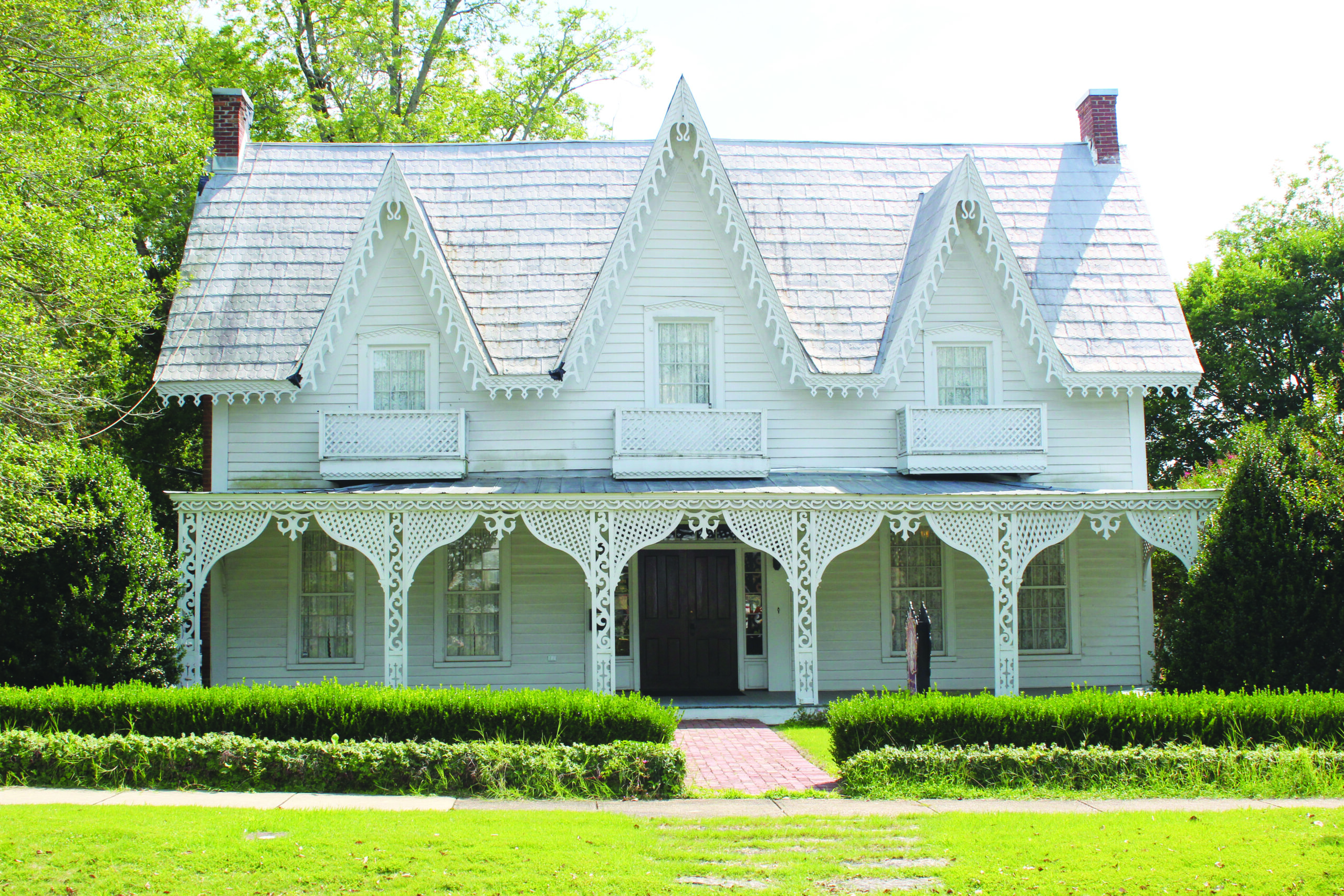By Ann Cipperly
Opelika Observer
Steep gables and porch columns adorned with lattice and icicle-like trim on the eaves create a storybook look for the picturesque Gingerbread House on South 9th Street in Opelika. While it stood for decades as a reminder of early days in the town’s history, in the 1970s the unique structure began to fade and deteriorate, becoming in danger of being lost.
The Gingerbread House had been intriguing to me since childhood when my family would drive past the house. As a young journalist, I finally mustered up enough courage to knock on the door one sultry July afternoon in 1979.
Miss Sarah Lula Bean opened the door and stared at the nervous reporter, carrying a heavy camera bag, before offering an invitation to enter. As we sat at her kitchen table, Miss Bean began telling her family’s story of her great-grandparents, John Calhoun and Sara Jane Griffin Edwards, who built the house.
When questions were asked, she presented an old family Bible with exact dates of her great-grandparents’ births, marriage and deaths, along with other family information.
Miss Bean explained that her great-grandmother and grandmother lived to reach their 90s, and the story of moving into the house was told over and over.
Her great-grandparents built the house to resemble the William Penn Yonge house at Spring Villa. According to family history, the house was finished in September 1865.
Miss Bean’s story began with the end of the Civil War in April 1865, and, like other southerners, the Edwards were beginning to rebuild their lives. They had spent the Civil War years at plantations located 12 miles to the east of Opelika, not far from the Penn Yonge house.
With similarities between the Edwards’ home and the house at Spring Villa, many wondered if the same carpenter built both houses. Horace King, master bridge builder and former slave, was known to have built the Yonge house in 1850 for the daughter of his former owner with whom he had a lasting friendship.
Family records indicate the builder of the Gingerbread House was most likely John Edwards, as he was a master carpenter and built other houses in Opelika.
Miss Bean believed the Edwards moved in the house on a Saturday afternoon in September 1865 with a two-year-old son and a baby daughter. One son died before they moved to this house. Bean’s great-grandmother was 24 years old, and her great-grandfather was 27.
Bean had been told that since the Civil War was over, the Edwards brought a young black couple and their two children with them to the house. Later, the Edwards had four more children, two sons and two daughters. The couple had 10 children born in the house.
Originally, the property the house occupies extended from 9th Street at Ave. C back to 10th Street. The Edwards also owned the triangle shaped property across the street where they grew strawberries.
Some of the furniture the Edwards moved to their new home from the plantation was still in the house. Bean had two beds, which were wedding gifts to the Edwards, and washstands.
Miss Bean was her parents’ only child. They divorced when she was five years old. Her grandfather, Dr. Samuel Henry Saul, was a veterinarian in Montgomery. Bean’s grandmother lived in the house with her mother after Dr. Saul died.
Although Bean had little to say about her great-great-grandfather, Loxla Edwards, the Rev. F.L. Cherry wrote about him in the history of Opelika, as well as did J. Newell Floyd, who has a family connection, in “The Heritage of Lee County, Alabama.”
John Calhoun’s father, Loxla Edwards, was a prominent early settler.
Cherry wrote that Loxla was born April 4, 1800 in Jones County, Ga. He married Olivia Brown in Jones County on March 1, 1824. He first moved to Talbot County and then to Russell County, about a mile and a half from Opelika in 1834. He had a small store and traded with the Indians.
Three months later he moved near what is now known as Spring Villa where he built cabins and opened a plantation on a small creek known as Edwards’ Creek.
Loxla quickly prospered and built another home in 1847 where his daughters were married and his sons given a marriage festival. John Calhoun and Sara Jane Griffin were married at her father’s home. Andrew Bonapart Griffin was also a prominent early settler and state senator.
“All of these occasions were enjoyed by his neighbors, sons and daughters without distinction,” wrote Cherry. “He was democratic in all things, as well as politics. At this late day, I remember those fetes with other pleasurable associations of my early manhood.”
Cherry wrote in detail of the flare-ups Edwards encountered with Native Americans, who killed his brother, and the attacks on his family.
He also wrote of an incident with a squad of six stragglers of Wilson’s Raiders who intruded on Loxla and his family, hanging him until he was nearly strangled and stealing from his home. Cherry records they would have left him hanging if not for the pleas of three of his faithful servants.


